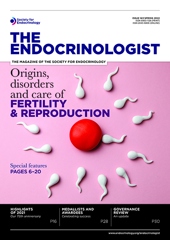Infertility is a common health problem, estimated to affect one in seven couples worldwide. Its effects are largely unseen, yet fertility problems have a profound impact on psychological well-being and quality of life. Male infertility accounts for around half of all cases.1
Although treatable, endocrine conditions affecting spermatogenesis (for example, hypogonadotrophic hypogonadism) are rare. More commonly, low sperm count and/or reduced sperm motility are apparently unexplained. And, in the absence of any other treatment options, many couples embark on in vitro fertilisation (IVF) or intracytoplasmic sperm injection, which are expensive and invasive yet without guarantee of success (25–30% live birth rate per treatment).
There is clearly an unmet need for the development of treatments for male factor infertility2 but, before we can tackle this global health problem, we first need to better understand how sperm work.
UNDERSTANDING HOW SPERM FUNCTION
The huge spectrum of sperm function required for a sperm to swim, find and fertilise the egg includes progressive motility, capacitation and hyperactivation, chemotactic responses, acrosome reaction, zona binding and oocyte activation.3 For those outwith the field of andrology, many of these terms will be foreign. Suffice to say, sperm start to swim in response to altered pH on ejaculation, are incapable of fertilising an egg until a complex series of events (termed capacitation) has occurred, and acquire sophisticated (hyperactivated) motility behaviour and the ability to acrosome react in parallel or as part of the capacitation process.
‘There is clearly an unmet need for the development of treatments for male factor infertility but, before we can tackle this global health problem, we first need to better understand how sperm work.’
Beyond that, the precise biochemical and molecular mechanisms underlying sperm function are less well understood. Notably, spermatozoa do not transcribe or translate, and therefore rely on post-translational modification for primary signalling mechanisms. For example, cAMP-dependent phosphorylation of flagellar proteins is required for initiation and maintenance of sperm motility. Ion flux and transport (ion channels and ionic gradients) also play an essential part in orchestrating intracellular signalling pathways and cascades, with a trilogy of ion channels (CatSper, KSper and Hv1) fundamental for sperm function.4
CatSper CHANNELS
Intracellular calcium (Ca2+) is critical to most, if not all, sperm physiological events, including motility and function in vivo, as well as IVF.5 CatSper (Cation channel of Sperm) ion channels primarily control Ca2+ entry into the sperm. Originally identified in mouse sperm, CatSper is expressed exclusively in spermatozoa and is essential for sperm motility and male fertility.6
The channel is large and complex and has defied in vitro expression to date. There are four alpha subunits (CatSper 1, 2, 3 and 4), which form the channel pore, and at least six auxiliary subunits (CatSper beta, delta, gamma, epsilon, zeta and EFCAB9), as well as a chaperone protein (CatSper tau). All subunits are required in order to produce a functional channel. CatSper channels are weakly voltage-dependent, Ca2+-selective and pH-sensitive, and located in four nanodomains arranged like racing stripes along the length of the flagellum.7
Perhaps not surprisingly, given its complex structure, CatSper activation is also complex and polymodal. For example, the application of progesterone to human sperm evokes an immediate Ca2+ influx via non-genomic indirect activation of CatSper. (Activation of abhydrolase domain-containing protein 2 results in loss of 2-arachidonoylglycerol CatSper inhibition.) A similar Ca2+ influx is seen in response to prostaglandin E1, although CatSper activation is direct.
Other physiological stimulants, such as cyclic nucleotides, zona pellucida glycoproteins and bovine serum albumin also stimulate Ca2+ entry into sperm via CatSper activation. Notably, CatSper is also activated by structurally diverse endocrine disruptor chemicals and xenobiotics.8 The issue is that, by mimicking the action of physiological ligands, these chemicals may interfere with the precisely co-ordinated sequence of events underlying fertilisation, resulting in impaired sperm function and male infertility.

Figure. Ion channels of the human sperm flagellum. Schematic representation of a human spermatozoon with cellular compartments and distribution of ion channels found along the principal piece: CatSper, calcium channel; Hv1, voltage-gated proton channel; Slo1/Slo3, potassium channels; the identity of a Na+ channel or transporter is yet to be characterised. ©2022, Lishko PV & Mannowetz N, with permission from Elsevier. See ref. 6
Hv1 AND KSper CHANNELS
Hv1 is a voltage-gated channel that mediates the outward flow of protons (H+) to the extracellular environment. Hv1 is critical for capacitation, hyperactivated motility and acrosome reaction.4 Hv1 domains are located longitudinally along the sperm flagellum, although they are distributed asymmetrically and therefore regulate rotational movement.9 Hv1 represents an important component in the CatSper activation cascade, but also induces membrane hyperpolarisation by exporting positive charges out of the cell.
Similarly, KSper (Slo3) channels maintain a hyperpolarised cell membrane potential (Vm) and, in doing so, influence the activity of CatSper channels.4
ION CHANNEL DYSFUNCTION
Importantly, ion channel dysfunction (ICD) has significant consequences for male fertility. Indeed, approximately 10% of cases affected by low or no fertilisation at IVF can be attributed to (predominantly KSper) ICD.10
This raises an exciting possibility for diagnostic or therapeutic intervention. Pharmacological agents to correct ICD could offer huge potential as new treatments for male infertility. Given that they are unique to sperm, direct or indirect CatSper agonists are a particularly attractive prospect, due to negligible off-target effects. Excitingly, high throughput and phenotypic screening drug discovery approaches have recently been developed,2,11 but the reality is that delivery of new treatments for clinical use is a lengthy, complicated and costly process.
A diagnosis of male infertility can be one of the hardest challenges a man can face. Here’s hoping science can make a difference.
Sarah J Martins da Silva
Senior Lecturer in Reproductive Medicine, School of Medicine, Ninewells Hospital and Medical School, University of Dundee
REFERENCES
- Agarwal A et al. 2015 Reproductive Biology & Endocrinology 13 37.
- Martins da Silva SJ et al. 2017 Human Reproduction 32 974–984.
- Ritagliati C et al. 2018 Mechanisms of Development 154 33–43.
- Brown SG et al. 2019 Human Reproduction Update 25 758–776.
- Williams HL et al. 2015 Human Reproduction 30 2737–2746.
- Lishko PV & Mannowetz N 2018 Current Opinion in Physiology 2 109–113.
- Chung JJ et al. 2017 eLife 6 e23082.
- Brenker C et al. 2018 Human Reproduction 33 1915–1923.
- Miller MR et al. 2018 Cell Reports 24 2606–2613.
- Brown SG et al. 2016 Human Reproduction 31 1147–1157.
- Gruber FS et al. 2020 eLife 9 e51739.







